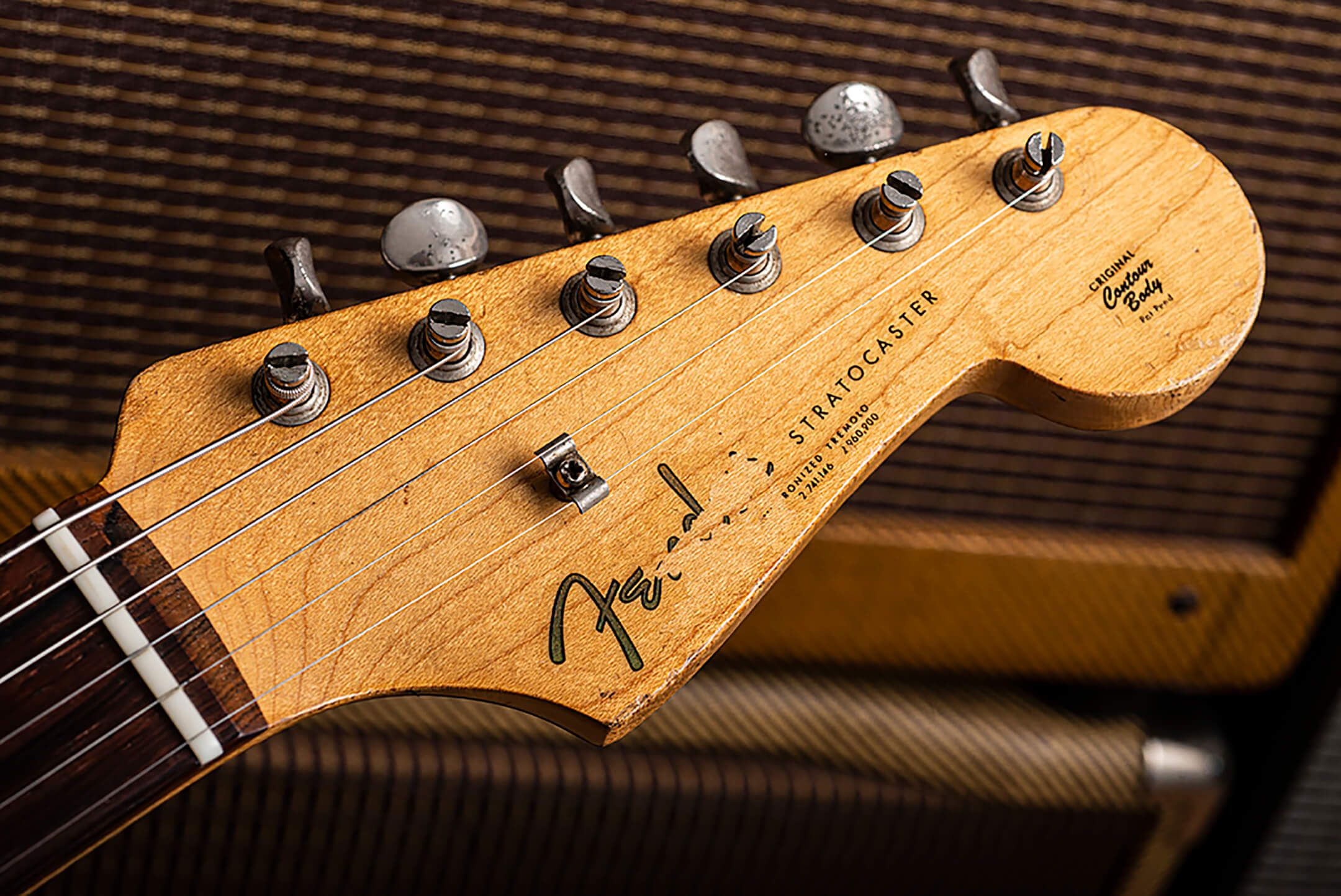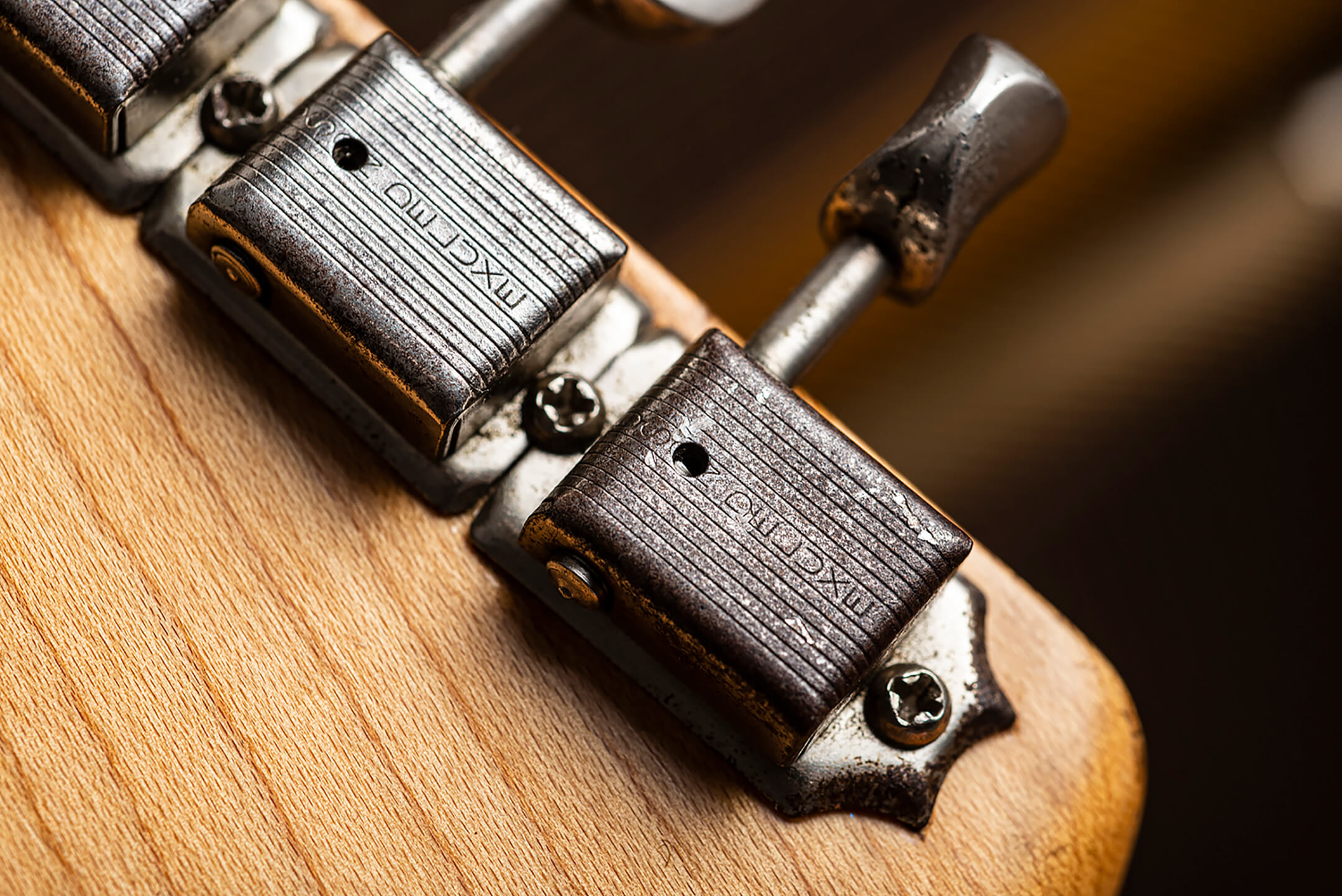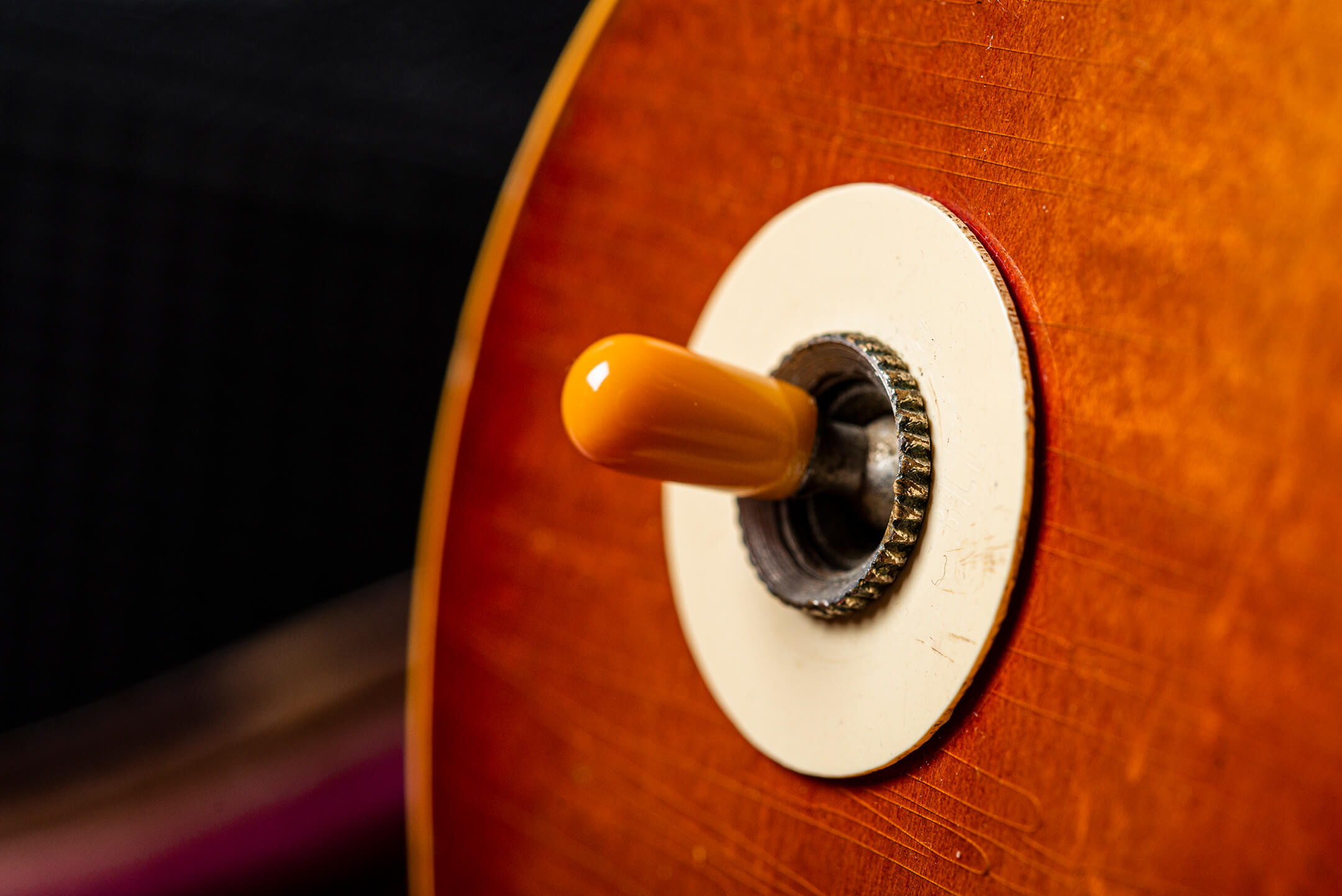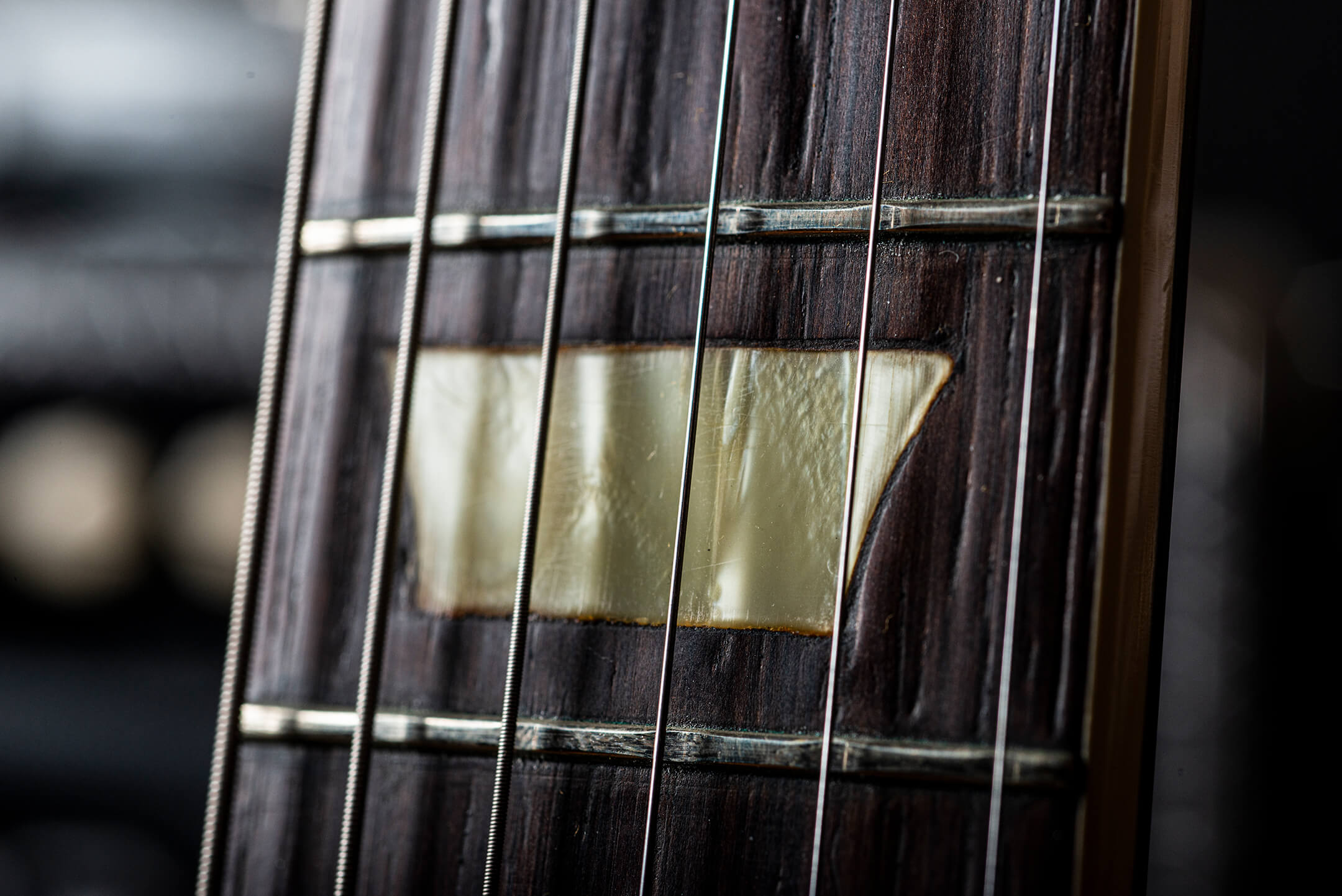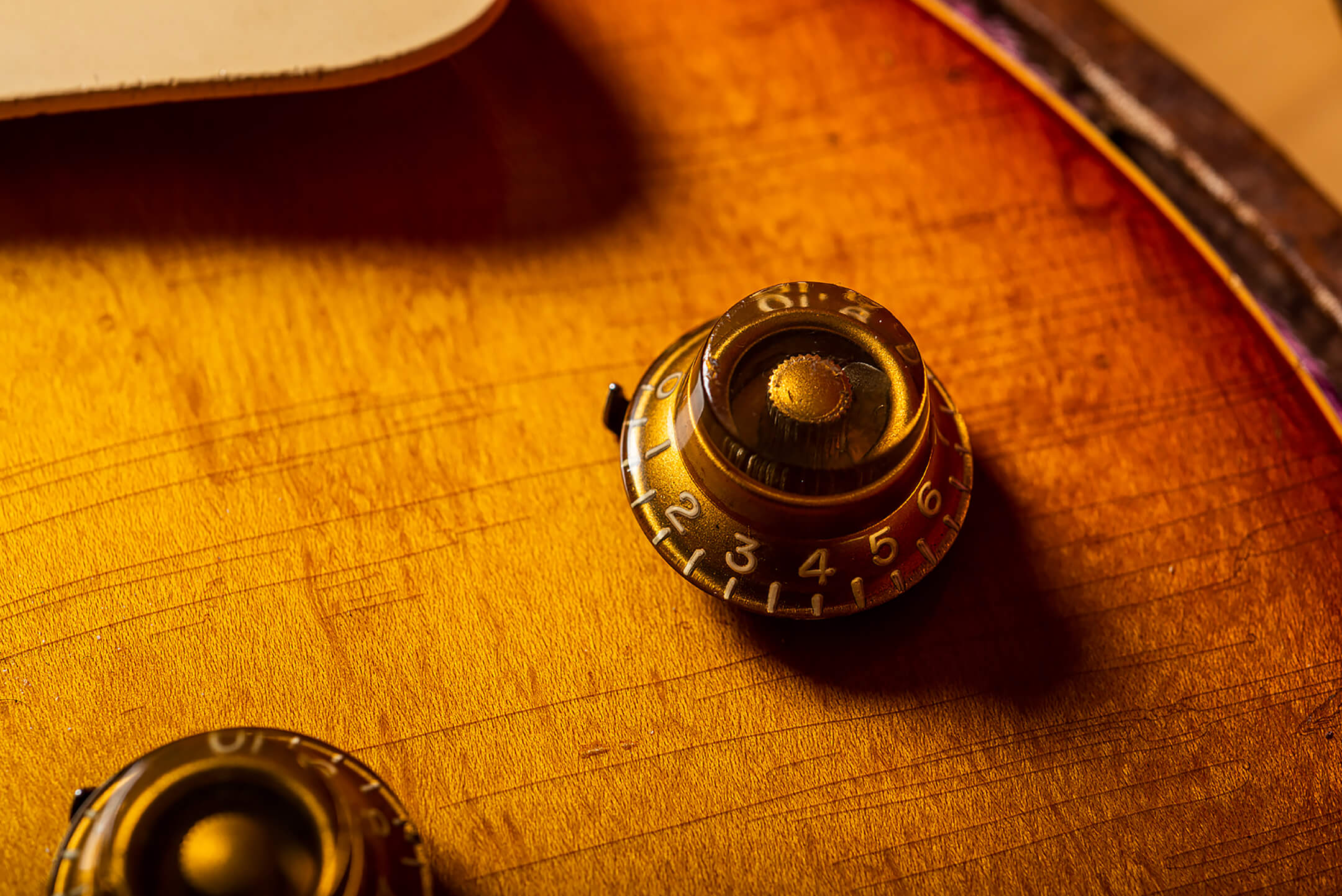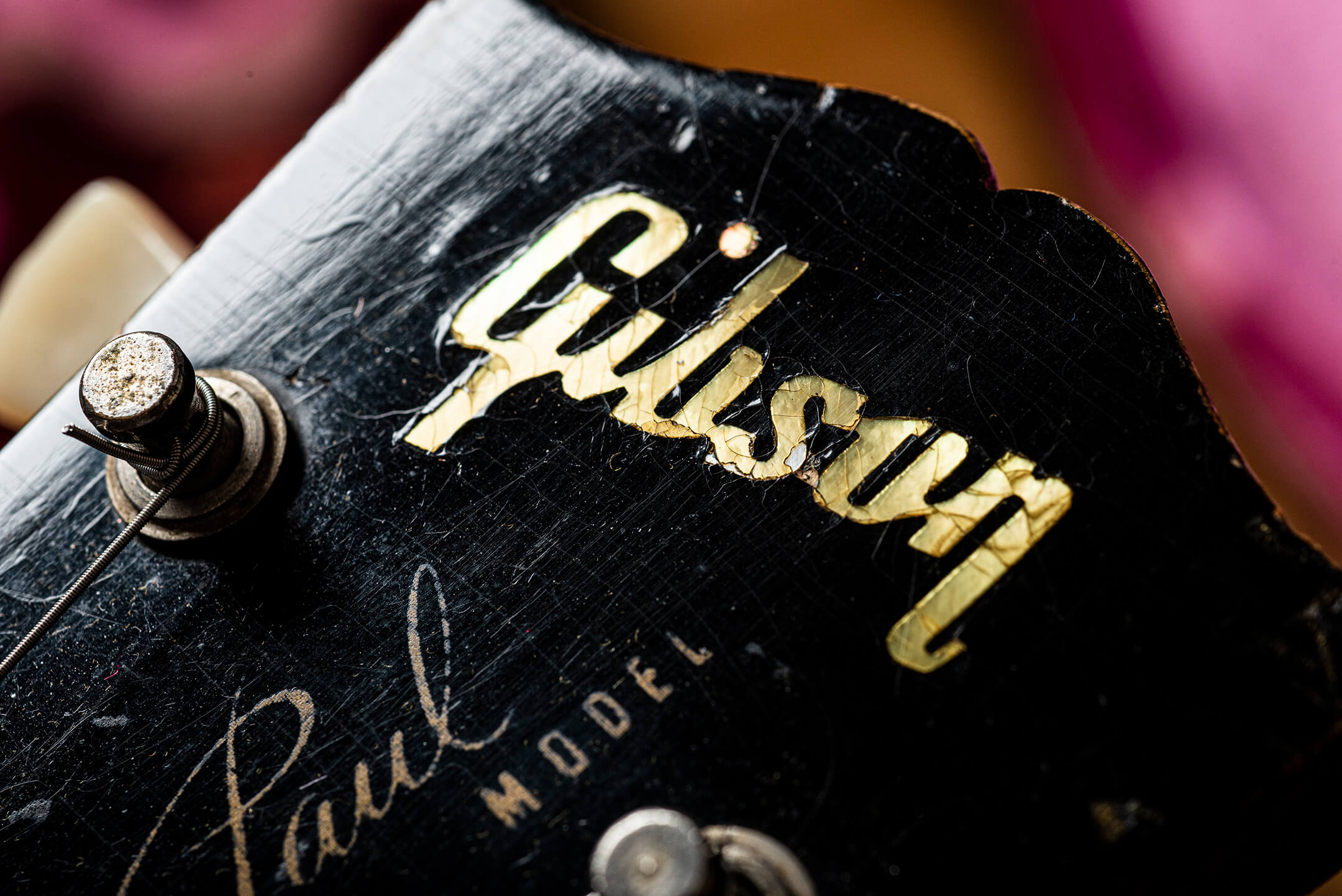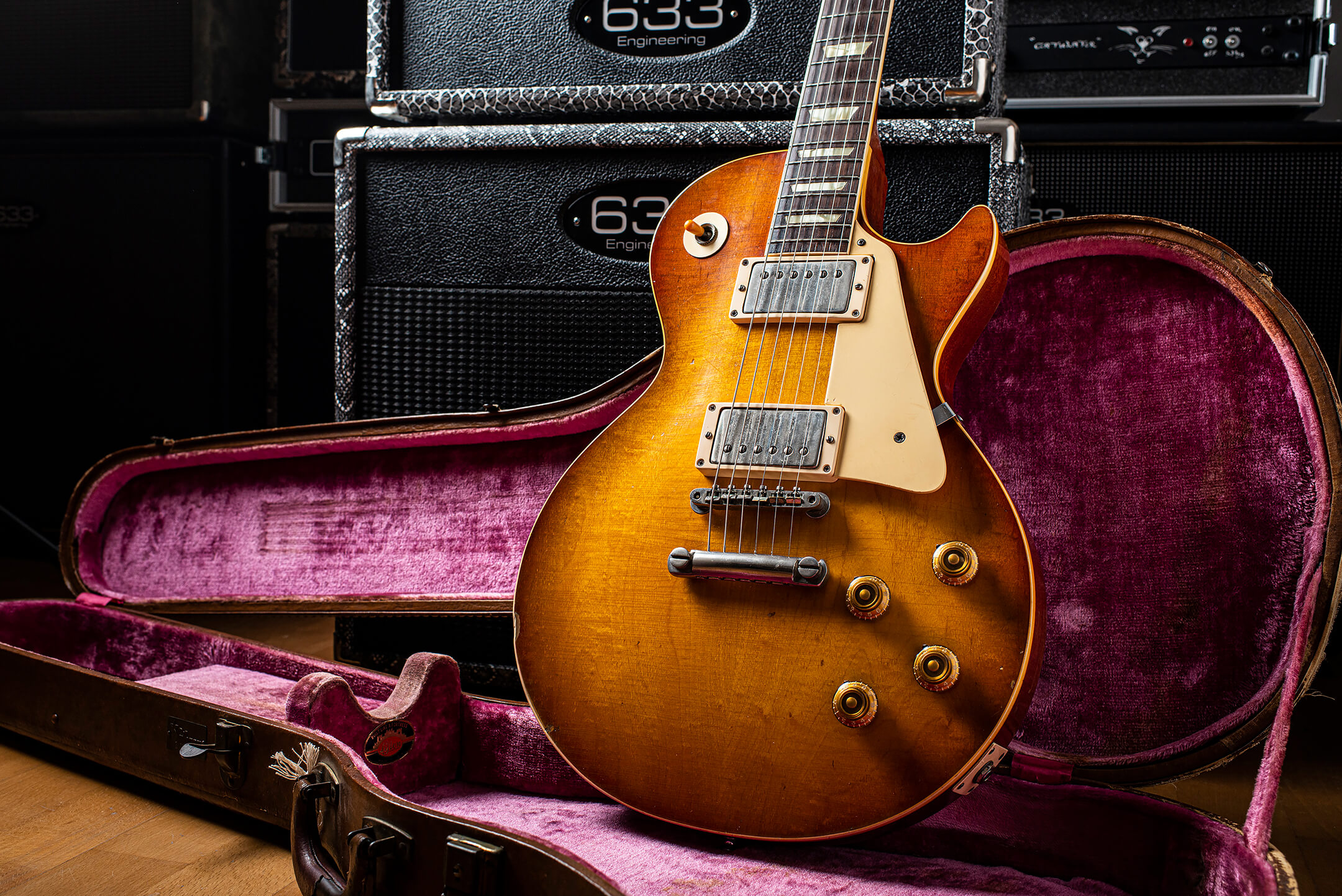Related Tags
The Collection: Bob from Rockbeare Guitars and his 20th-century toys
We head to London to meet a British guitar collector with a penchant for old Gibsons and an eye for detail.
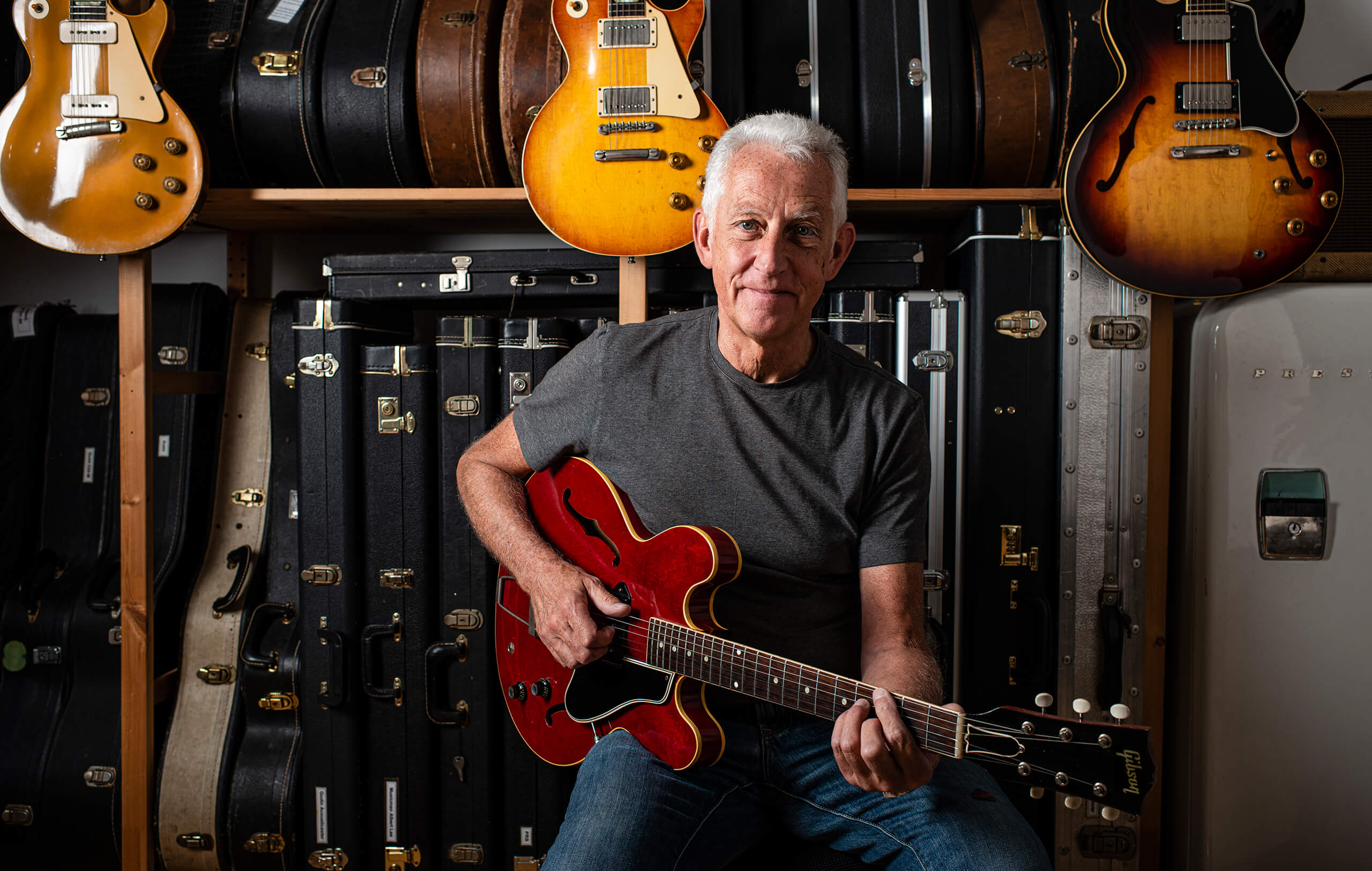
Guitar collectors who set their sights on big-game vintage pieces often get a bad rap for their presumed Smaug-like acquisitive impulses and tendency to lock guitars away, doomed to remain unplayed behind glass or in bank vaults. It’s a rather unfair stereotype, of course, and in the case of the collector we’re meeting today, the cliché could not be further from the truth.
A phenomenal blues player and former acolyte of Robert Fripp’s League Of Crafty Guitarists, our host’s real life in advertising took him in a different direction, but it’s no exaggeration to say that Bob can more than hold his own as a guitarist. Due to the high value of some of the instruments in his collection, the precise details of Bob’s identity and location remain closely guarded, but those of you who trawl YouTube for guitar content may have seen him appear as a co-presenter with his friend Ramon Goose on The Guitar Show, or on his own Rockbeare Guitars channel.
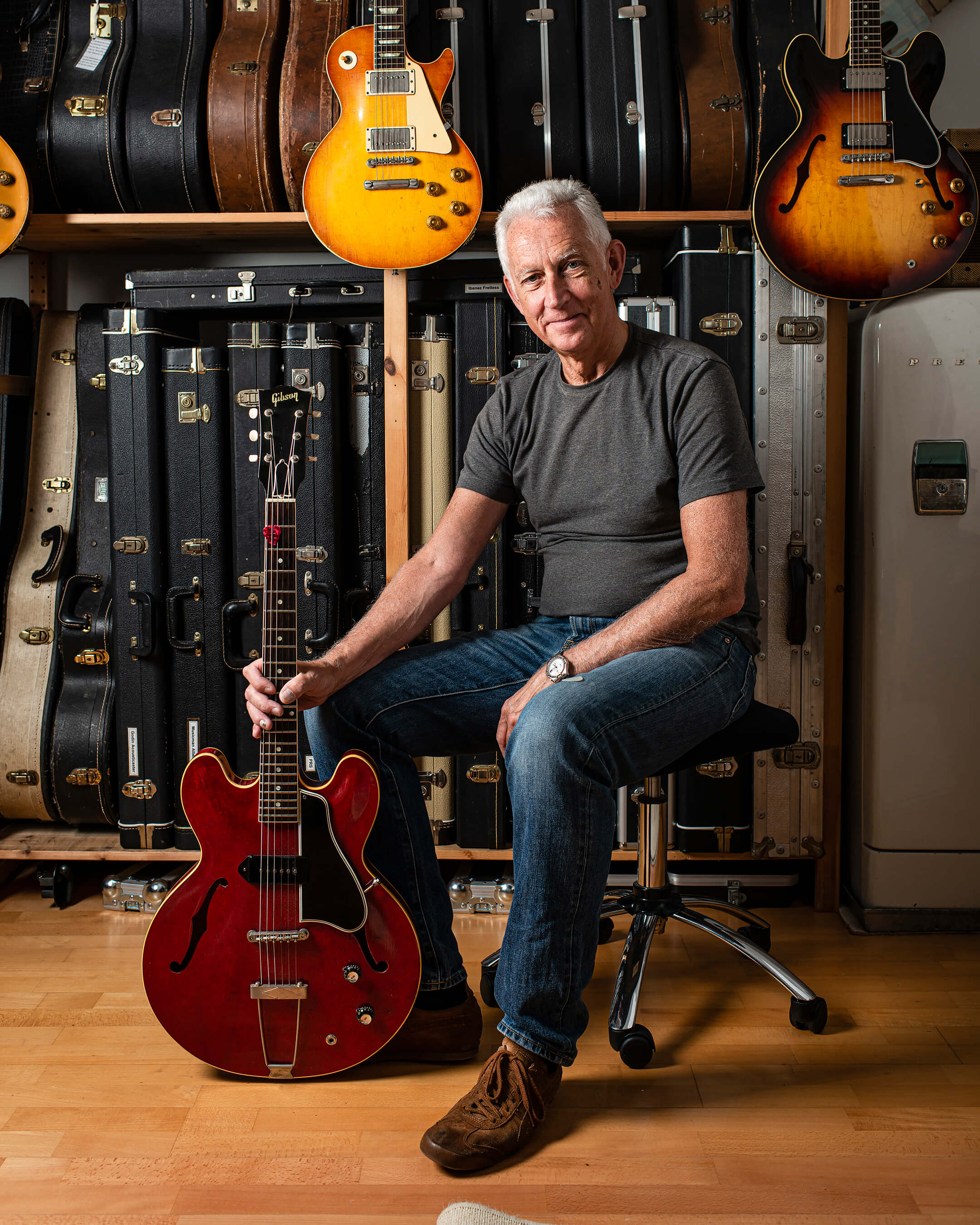
Bob’s guitar arsenal is extremely varied and contains many exceptional instruments but here, we’re concentrating on the vintage end of the spectrum as he talks us through the highlights, from gorgeous Gibsons to a Gretsch, a Guild and a very special Strat. Buckle up, it��’s going to be one hell of a ride.
1955 Gibson Les Paul Junior
“This was bought on my 60th birthday because I’m a 1955 too. The P-90 is slightly closer to the bridge, which can be an issue as the bridge posts often lean forward and crack the wood. That has not happened here. If you’re looking for the Leslie West sound then this does it.
“It has an original snakeskin cardboard case, which I bought later. Those things are going for silly money. When we look at the ’58 Burst I’ll tell the story of the switch tip, which truly puts me in the category of dangerous psychotic wanker!”

1960 Gibson Les Paul Junior
“I’ve had this one for a while now. The serial number puts it well into 1960 but it has a big 1959 neck profile. It’s all original in fabulous condition, and it’s a really loud guitar! I love gigging this guitar. It stops the traffic.
“All the TV Yellow Juniors had ‘TV model’ on the headstock decal but from late ’59 the Specials do not. I don’t know why. The Special we’ll see next is blank.”
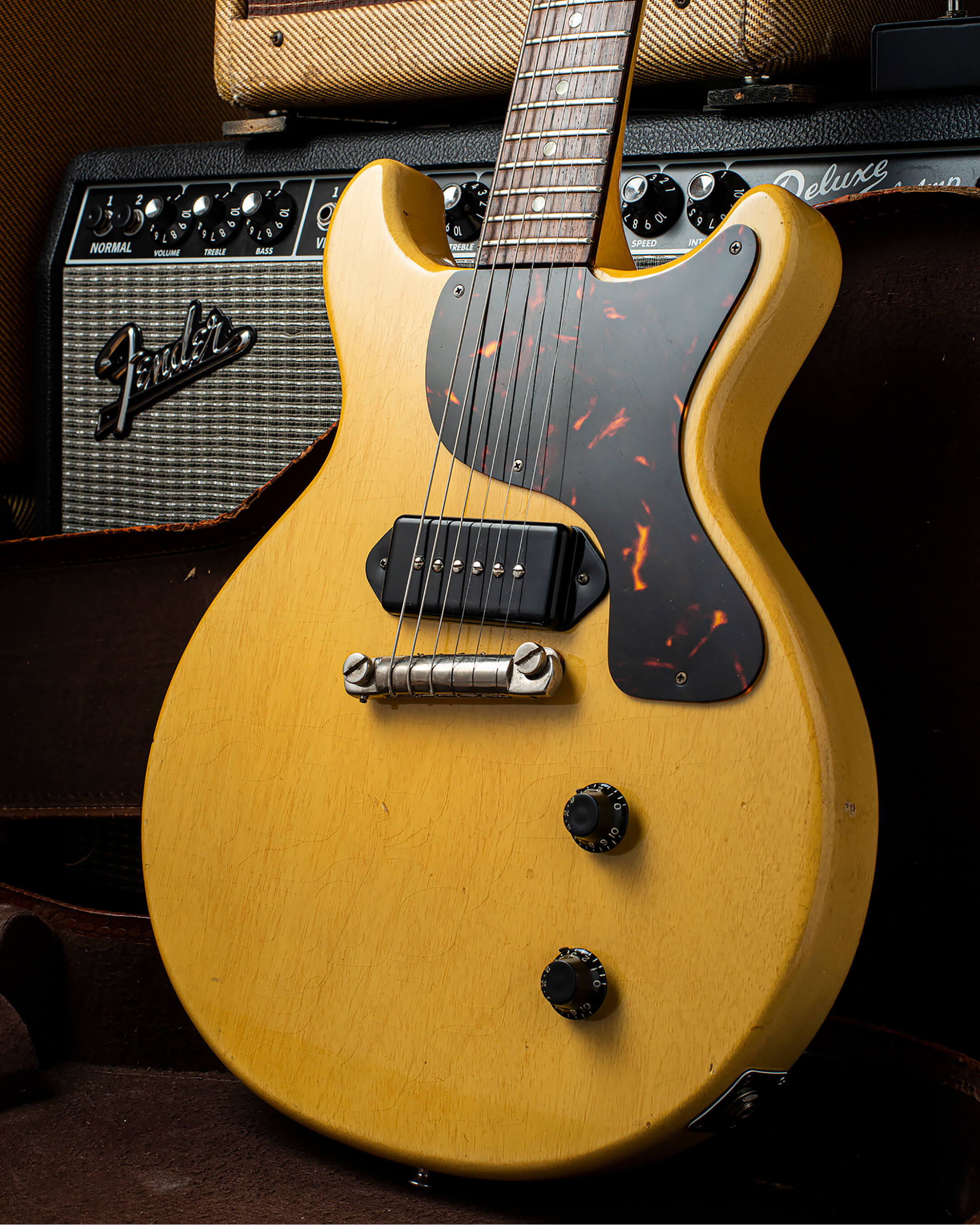
1960 Gibson Les Paul Special
“This is the two-pickup Special – another slab body student model. It’s not as immediately appealing as the DC Junior, especially at low volumes, but you get the added flexibility of the neck pickup which in this case is very sweet.
“When you crank it up it really does speak. Quite a legitimate instrument for a blues situation. If you go by the serial number this is an earlier guitar than the TV Junior, but the neck is very definitely a 60s skinny carve.
“I’ve never been that keen on the bound fingerboard. From a feel point of view I like the unbound Junior necks more. It’s a personal thing. It’s a great guitar though, and it gets a fair amount of use.”
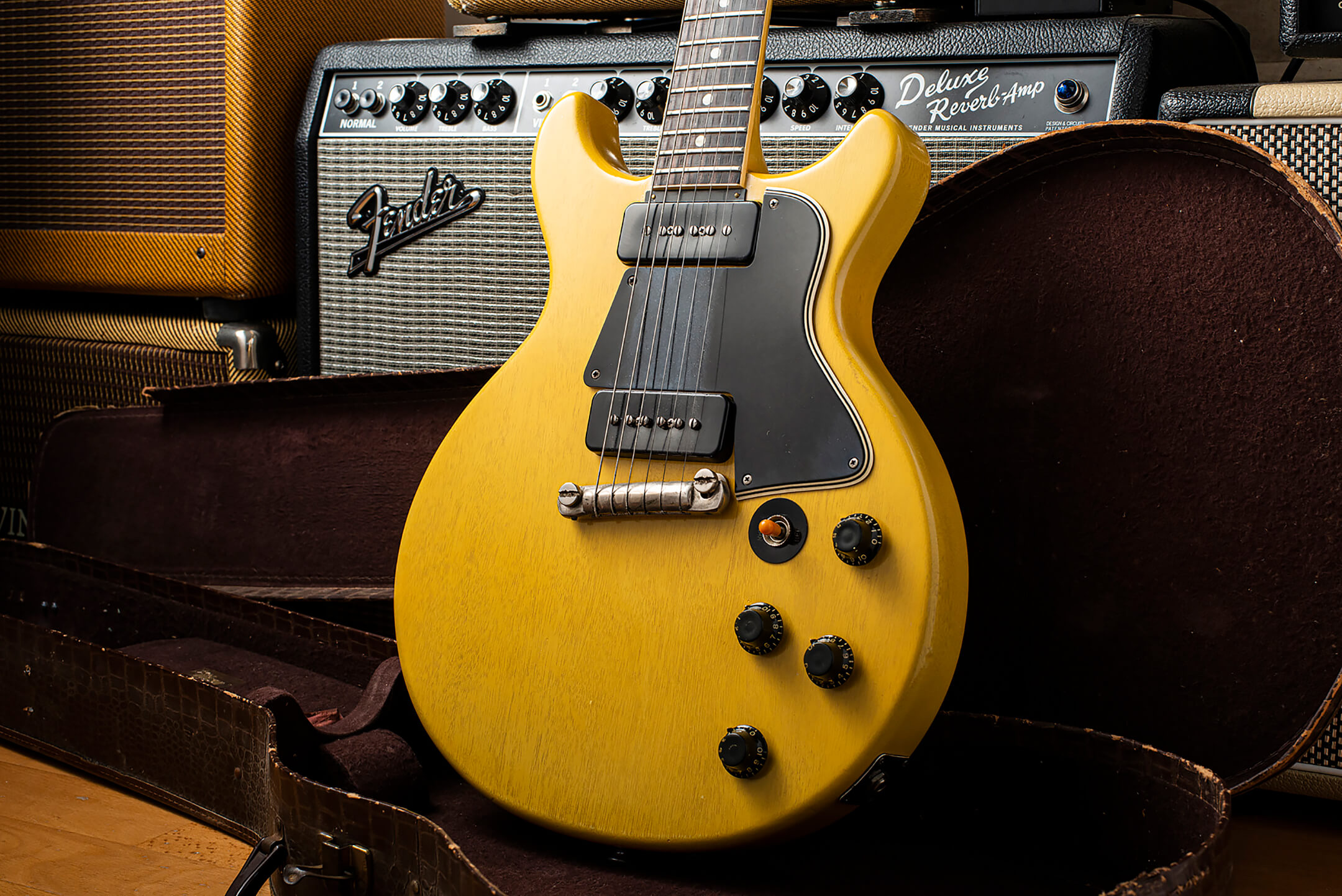
1964 Gibson Firebird VII
“It’s a corking guitar this – but more fragile than biscuits. It belongs to a very dear friend and it’s here for a sleepover but what the hell, we might as well show it off!
“These are very rare guitars, they only made 173 that year and 382 ever. The middle position is the middle and bridge pickups together, the same as a Les Paul Custom. Provided you don’t try and dive bomb on this guitar the Vibrola really adds a fantastic amount of movement and shimmer to the sound – I wasn’t sure at first but it’s really grown on me!
�“These guitars are very famous for breaking, they have that long headstock, the banjo tuners that get caught on anything near you, there is no neck volute and if you try and lean one against an amp it’s going to plummet downwards. They’re pretty heavy guitars with no real balance to them until you strap one on. Then they feel wonderful.
“A lot of players don’t like triple-humbucker guitars because they say the middle pickup gets in the way but I am a big fan of a centre-mounted pickup, as you’ll see!”
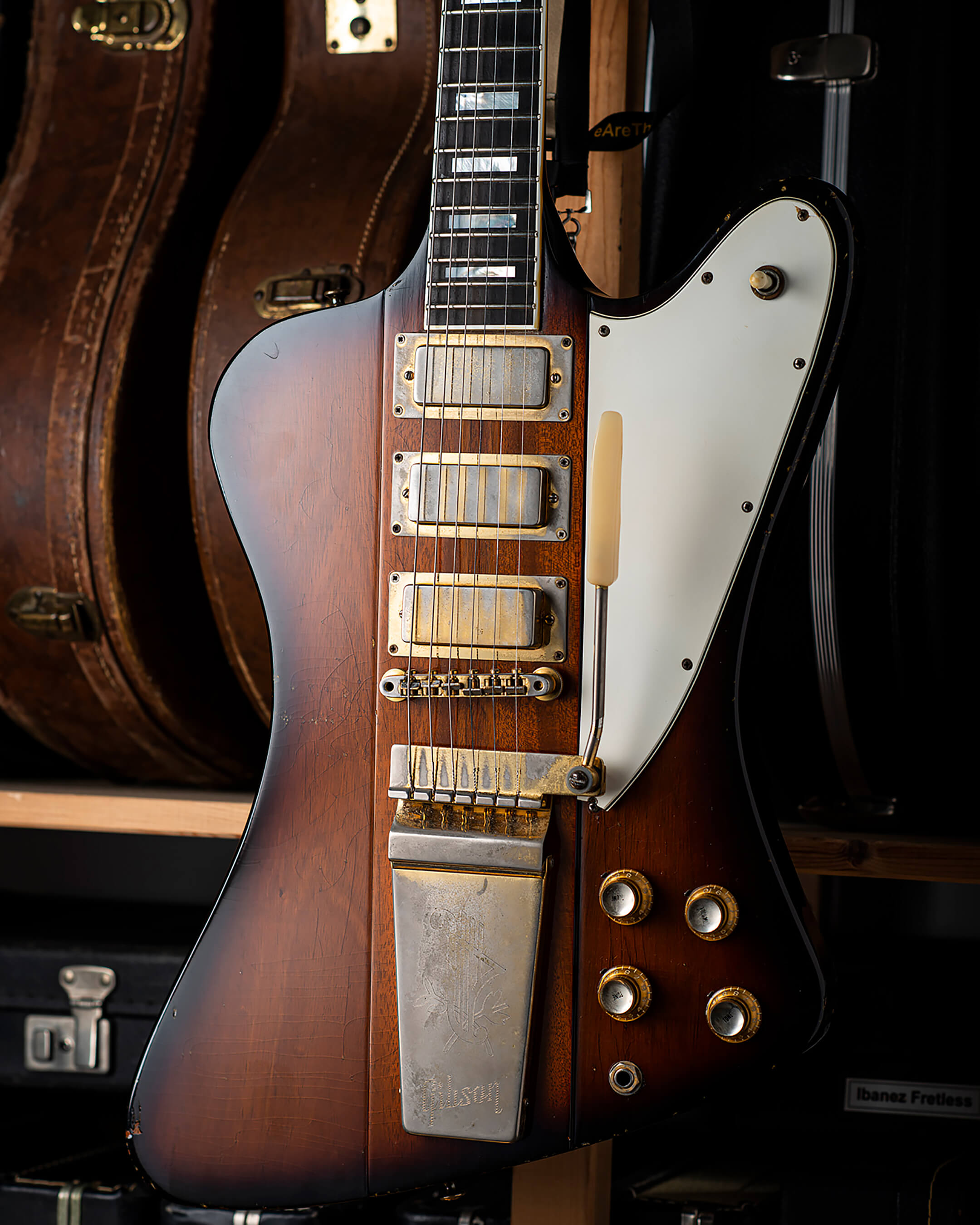
1954 Gibson Les Paul
“This has got dear [famed guitar tech to the stars] Bill Puplett’s label on the case. The trouble with playing a lot of nice guitars is that it’s rare for one to become a true extension of you, as you’re constantly flirting with the whole collection, but I know that this guitar will follow wherever the music takes me.
“This is the second iteration of the Les Paul. I think it’s the nicest looking configuration – it’s very pleasing. This one has a pretty typical ’54 neck carve, quite round. The original frets were on it when I bought it and they were absolutely worn out. I had it refretted with high, narrow wire so I can grip the strings and bend but the frets still look pretty authentic from the front.
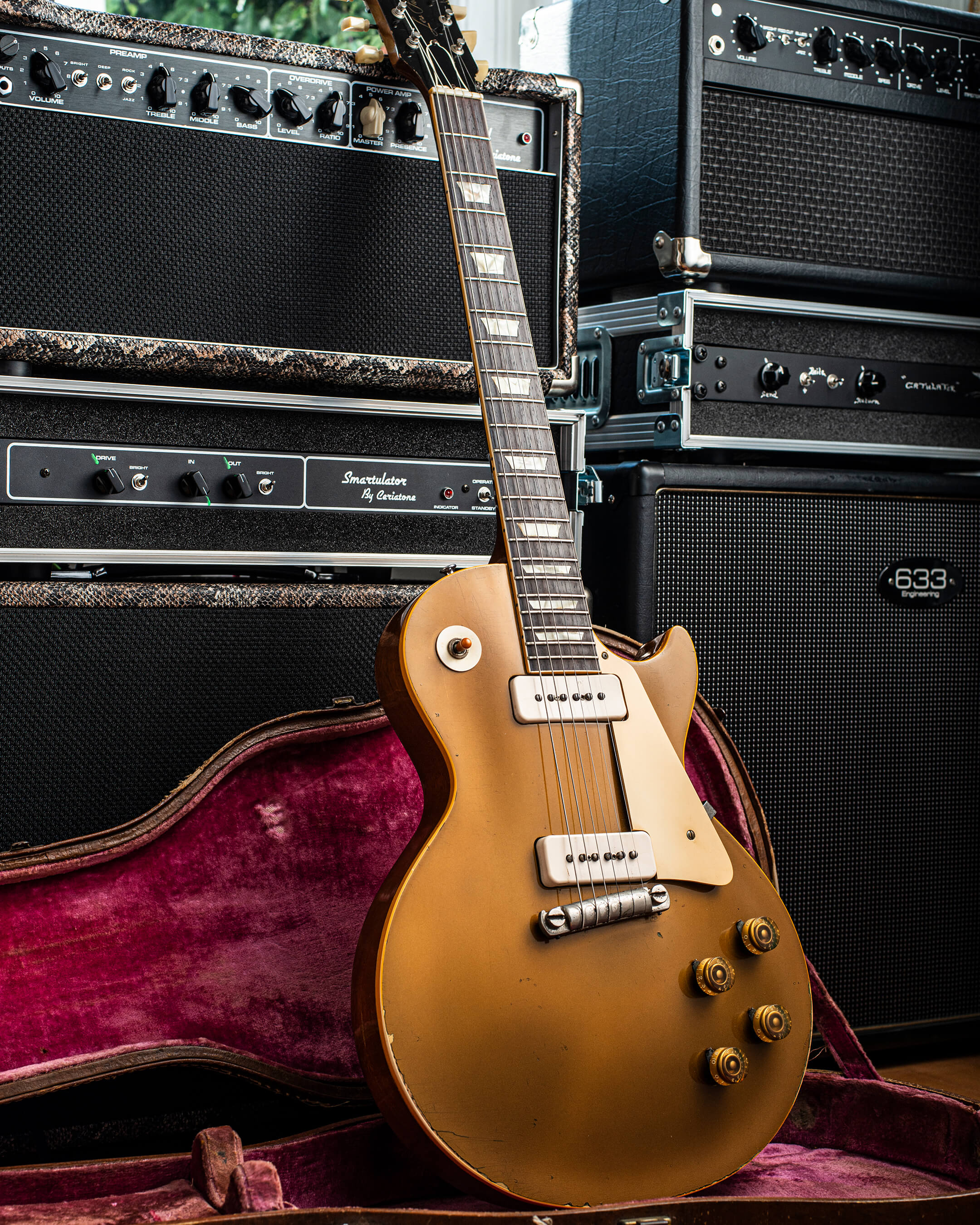
“It’s quite a growly guitar, which is typical for that period of P-90, and it opens up with a bit of heft – just wonderful at stage volumes.”
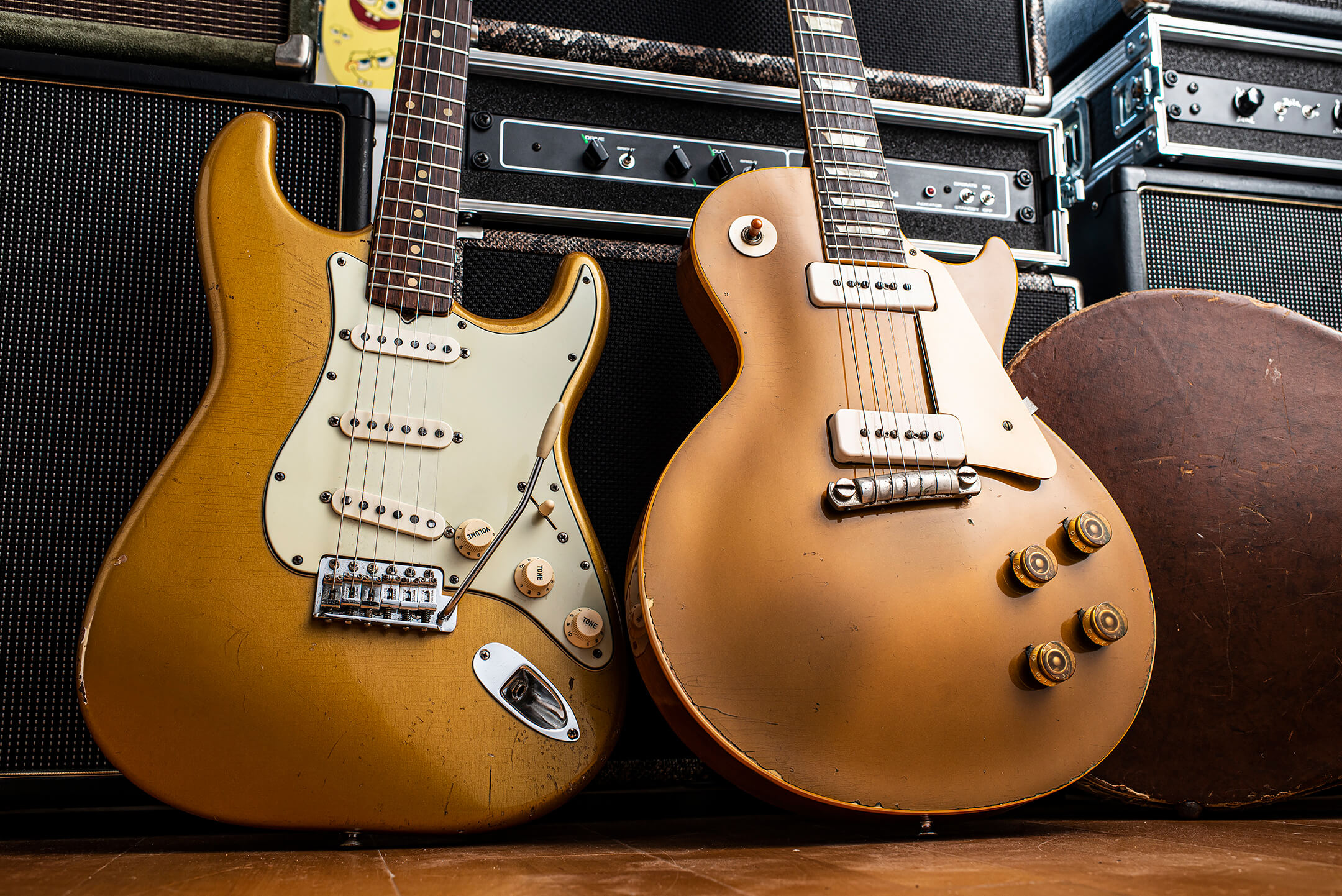
1962 Fender Stratocaster
“I’ve had this guitar since 1974. The neck and body are November 1961 and February 1962 respectively, if memory serves. I’ve had it refretted and the bridge pickup had to be rewound because it went ‘open circuit’. I had the tremolo and saddles re-chromed and while I have the original switch this is now a five-way. Everything else is stock.
“One thing that makes it slightly unusual is the Shoreline Gold finish, which is rare on a slab board ’62 Strat. Over time, the yellow on this guitar has got deeper making the gold even more vibrant – with no signs of calming down!
“It’s a joy to play, it sounds great and it has a big thick neck, much bigger than most skinny Strats of the period, which suits my hands much better. This was my main guitar for many years and it has been played a lot. ’57 and ’62 are the years for Strats and a rare custom colour in good condition is a joy.
“Leo Fender was a genius who applied the principles of mass manufacture to a hitherto craftsman built instrument. He was so involved with the artists as well and those close relationships played a vital role in the development of his instruments. And he built a guitar that a chimpanzee with a screwdriver could mend in between songs! All of these things are mark of truly customer-facing, user-oriented business and a master of design. I’d love to have met him.”
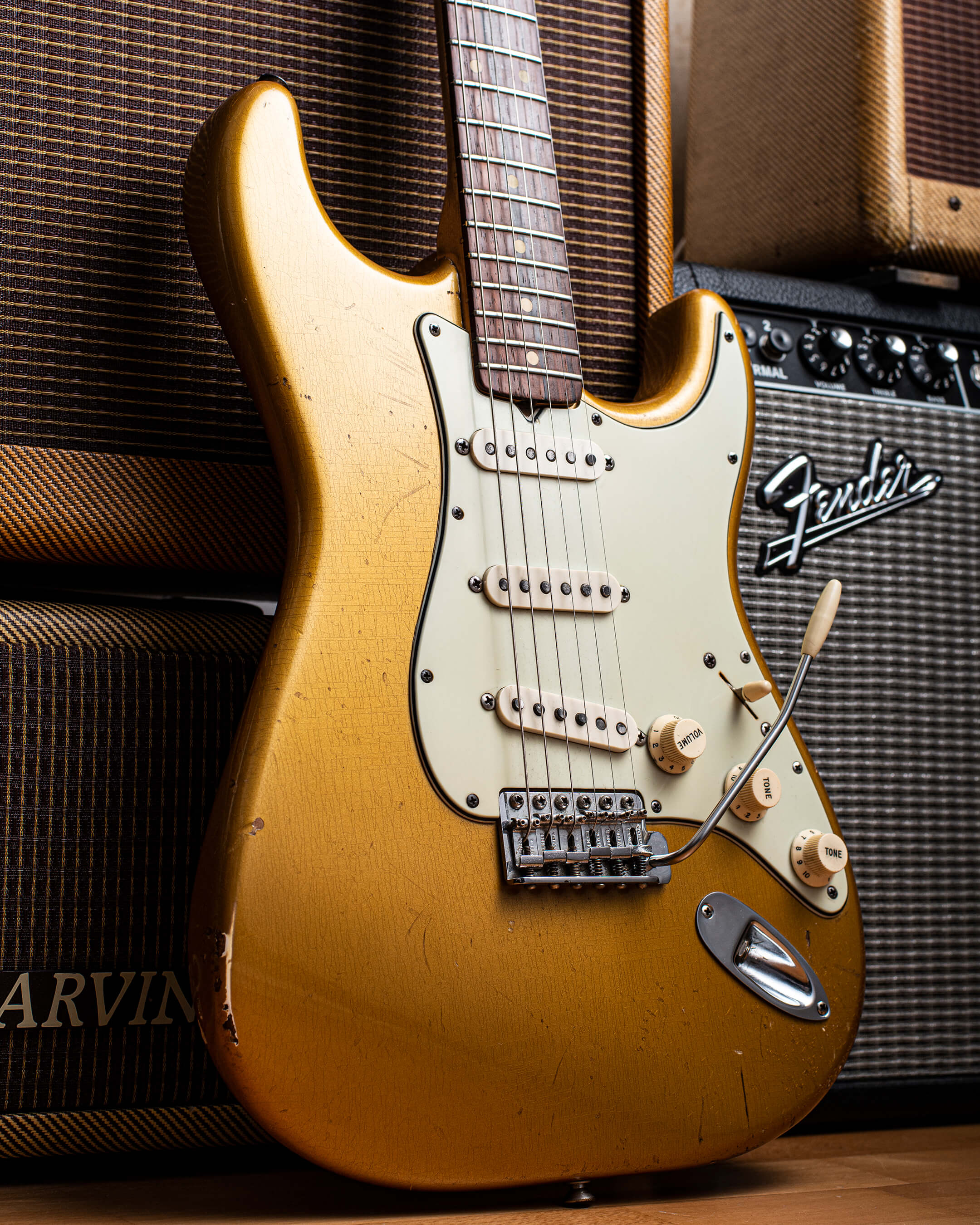
1958 Gibson Les Paul Standard
“I’ve had this since 1998. I was actually looking for a ’57 or ’58 Goldtop. At the time I didn’t have enough experience with vintage guitars to know what I was buying so I relied on the expertise of dealers – one in particular took me seriously and invited me in whenever something special came through, like a 1958 Flying V for instance. One day he called me about a guitar, came round to my house and when he opened the case I saw the Burst and said, “No, no no – this is big league… I don’t think I can do this.” But I trusted him and I’m glad I did. It was a lot of money back then but it’s worth a great deal more now. I will play this guitar until my fingers fail.
“I love this guitar because it’s a relatively plain burst. It came from the same batch as Mark Knopfler’s ’58 and he likes a plainer burst too. At the time sales of Goldtops were dropping off so Gibson tried sunburst finishes but by late 1960 they discontinued the guitar altogether and stuck the Les Paul name on the new SG shape.
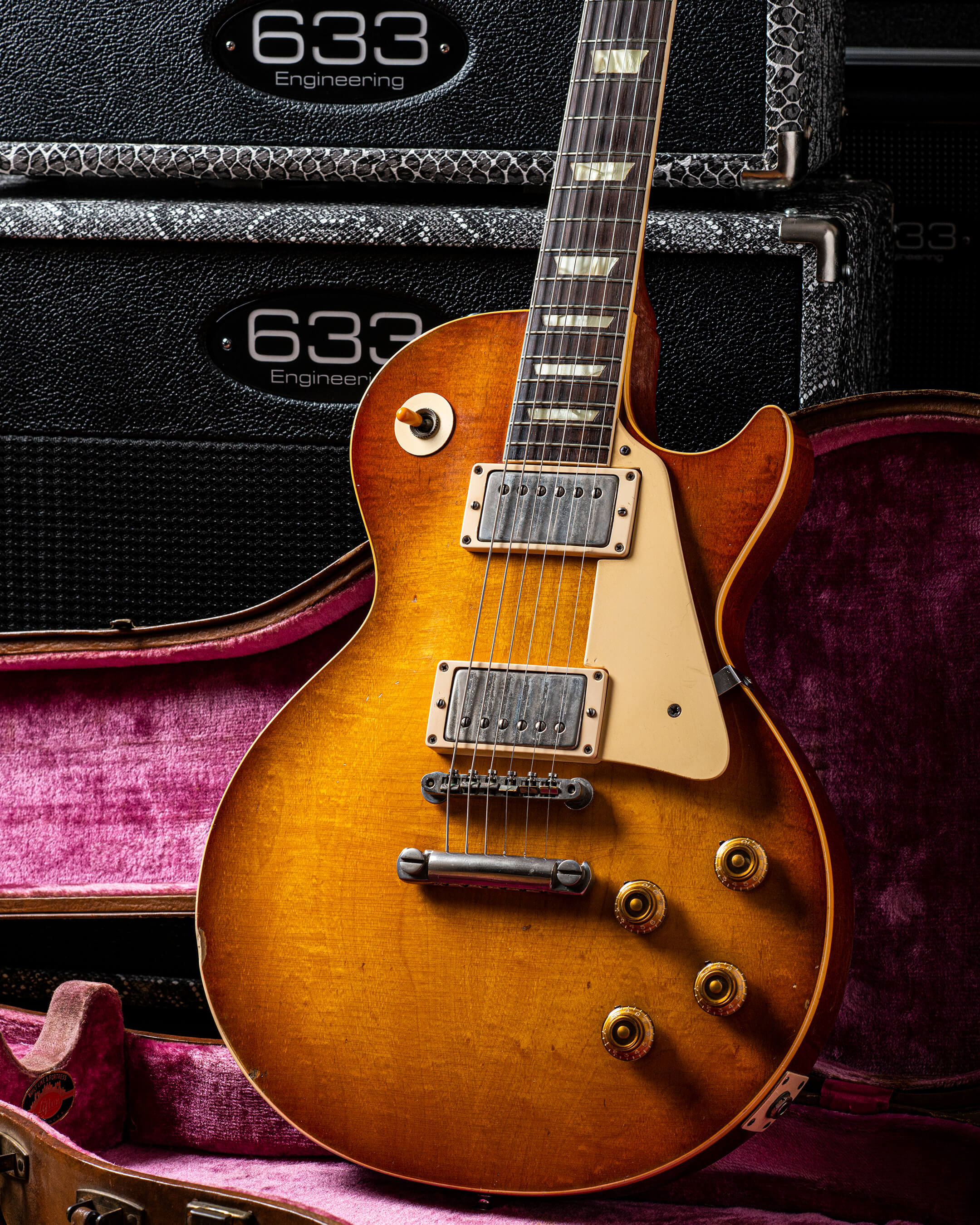
“Now… the story of the switch tip, I have to admit the guitar is currently wearing a Mark Foley reproduction switch tip from five years ago. When I bought the guitar originally the underside of the switch tip had a slight crack along it and one day it just went. I knew it was going to happen. You try and prepare yourself for a day like that.
“I got in touch with Clive Brown who was about to go out to Arlington [vintage guitar show] and asked if he could look out for one for me, which he did. It cost $400. That’s what kind of idiot you’re talking to. 400 fucking dollars. With a real switch tip you can smell the Catalin when you heat it up. Of course that’s a closed club as you have to have one in the first place to heat it up and sniff it!
“One of the great obscenities about one of these guitars, aside from idiots who are prepared to pay hundreds of dollars for a switch tip, is the price of original vintage pickup surrounds for the sharper-cornered original pickups. You’re looking at five figures for a pair in good condition and with provenance. I mean go away!”
1959 Gibson ES-335
“This has an original overcase – perhaps the most interesting thing of all about this ensemble in terms of sheer scarcity. This was a gift from a dear friend, a very emotional moment! It’s a raincoat for your guitar case. They were common in the 50s, particularly on the jazzboxes, but they are also highly perishable. Very few have survived. The case itself is in remarkable condition and the guitar, even more so. You would be hard pressed to describe it as anything other than mint.
“I bought this guitar sight unseen over the phone from a dealer in the USA. The price was slightly chunky and I had no idea it was this good. It’s interesting – here in Europe it’s more caveat emptor but in the USA, if you ask the right questions they will give you honest, detailed answers. It’s your job to know what the right questions are.
“The tuner buttons are replacements – the originals have crumbled and I’ve got them here in a plastic bag. There are two reasons why buttons deteriorate, the instability of the plastics of that era, and the lining of the case, the glues and the dyes especially, which gas off and corrode any gold hardware on the guitar and advance any innate instability in the plastic.
“This is my scariest guitar. Not because of its condition and value, but because it looks at me as a musician and says ‘You’d better be serious’ in a way that the Burst doesn’t.
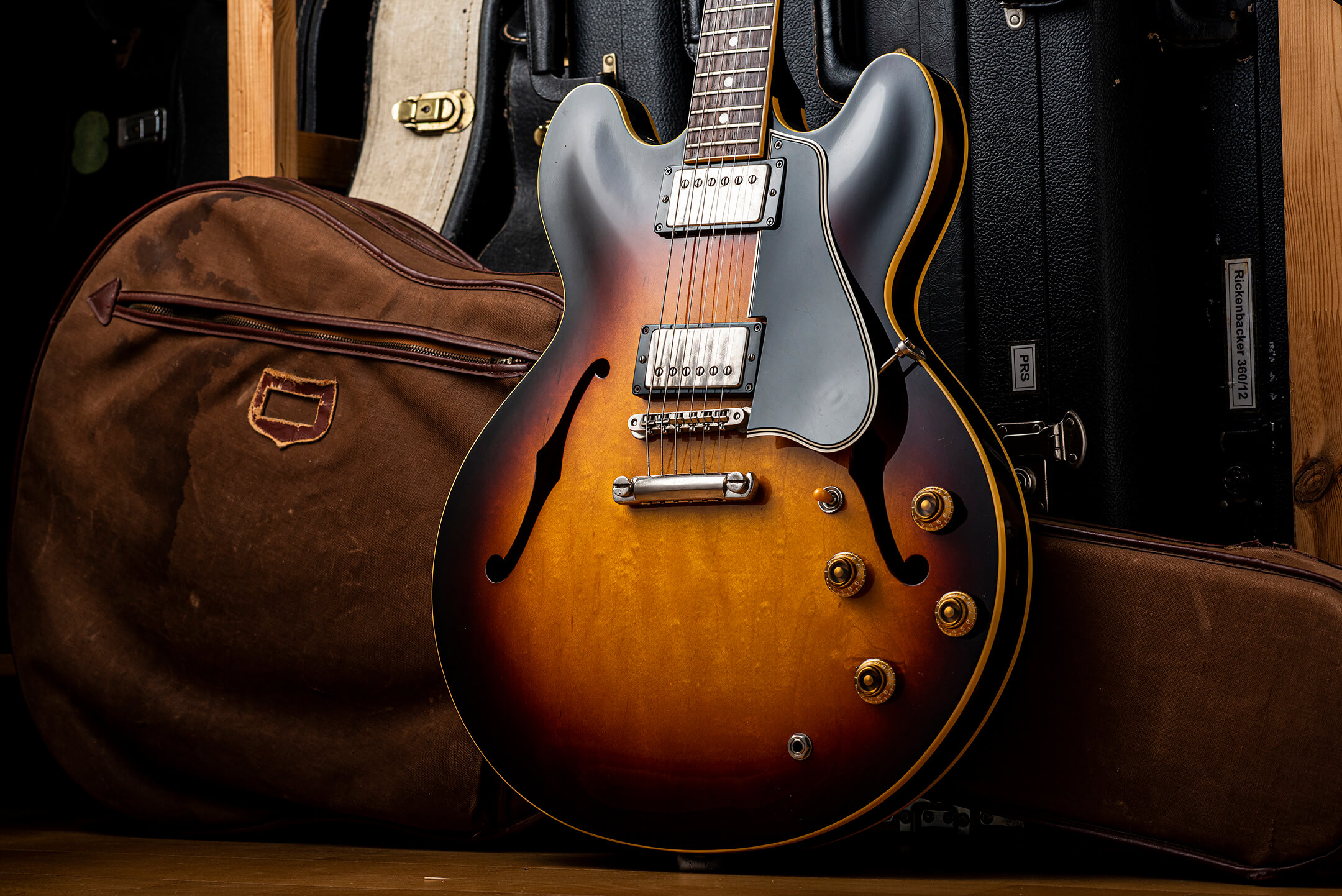
Single-pickup hollowbody trio
“I don’t even like Cherry guitars very much, but this 1961 ES-330 is my favourite of the whole collection. Every time I pick it up, I’m truly home. Serious 330 collectors will sniff at it because it’s a single pickup but these guitars are infinitely superior instruments because you don’t have any phantom pickup loading, and the centre mount is an incredible sweet spot for a P-90.
“Now, I don’t go for two of anything as a rule but I bought this guitar and I liked it so much that I decided to get another one. So I now also have this 1960 blonde which is almost as good a guitar.
“Having broken my own rule I decided to look for a sunburst to compete the set. By accident I came across this Epiphone E-230T online. Everything else the dealer sold was seven-string and pointy so obviously what happened is grandpa had traded in his old guitar in so Little Billy could get a shred guitar. That meant the dealer had something in his inventory that didn’t suit him and he was selling it at a good price.
“This is a very unusual guitar. It’s a 1962 and, being an Epiphone, the differences are the headstock and the trapeze. Everything else is the same. I believe there was just one production batch of these, that’s 36 guitars in double and single-pickup configurations, so probably only 11 of these were made. I feel very lucky to have it.
“These guitars do take off at higher volumes. I asked Gary Clark Jr how he stopped 330s feeding back. He said, ‘Got some old pyjamas?’. Vince Gill’s tech suggested an even better trick – those long thin party balloons that clowns bend into poodles. Shove a couple of those in through the F holes and inflate them! I haven’t tried it yet but that method is completely non-invasive for the wiring, whereas with the pyjamas you do run the risk of knocking something out of place…”
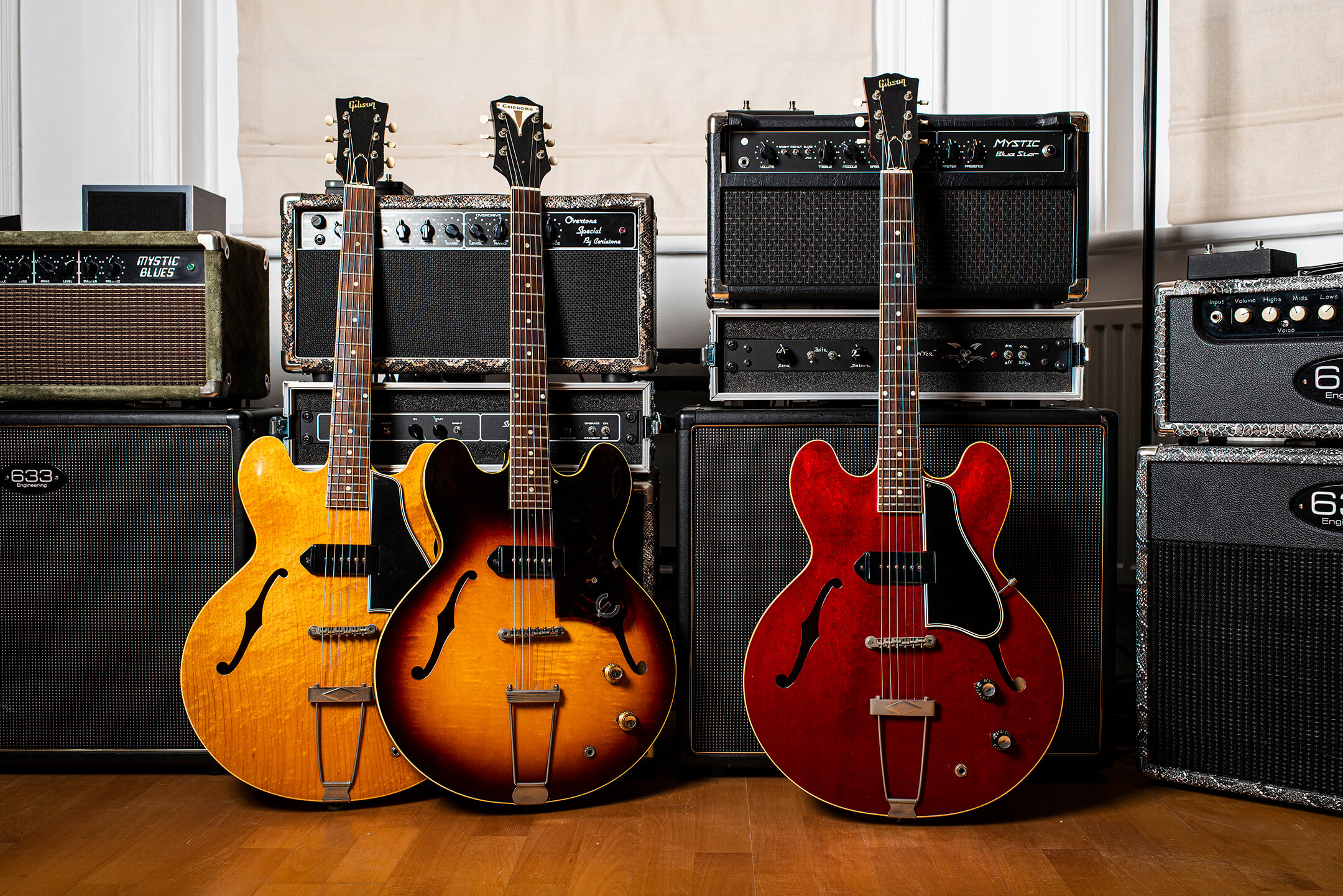
1957 Gibson ES-225
“This guitar has a similar story to the Epiphone in that I won it by accident in an online auction while getting a sandwich. It was out in Australia and when it arrived I opened it up and thought, ‘Oh no it’s a fake’. It was just too clean. Like so many guitars the scratchplate has dished a little; the different layers shrink at different speeds.
“In this case the single middle pickup sounds like the in-between position in a double pickup guitar. I know that’s technically impossible, but it’s true, there’s a gleam to it. It’s not the easiest guitar to play with its skinny frets and round, wide neck. You have to think about things a bit more but they’re whooshing up in value now.”
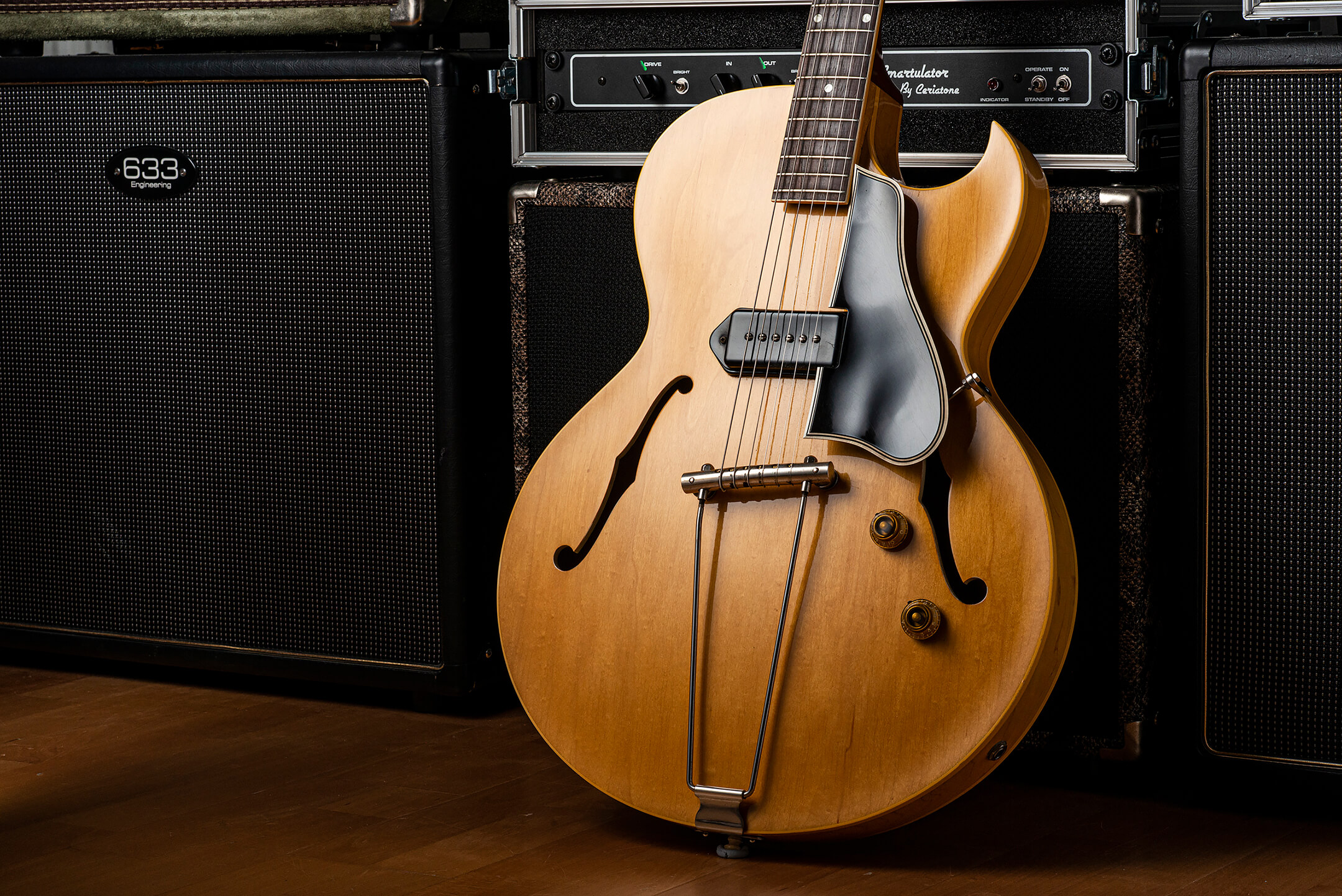
1953 Gibson ES-175
“This guitar sounds wonderful and really projects acoustically. Obviously it’s worked for its life. There’s sweat rash on the back and the case is that nasty green, but it’s old and honest. I traded it for a Gallien Kruger amplifier, which was just basically awful, in a straight swap!
“A lot of the 1950s ES-175 and ES-225 models have been stripped for parts, sadly. Although you couldn’t swap out the switch tip and put it on a Burst as the top is the wrong shape – in case you were wondering! Thankfully I have two or three friends that are prepared to indulge this kind of conversation!”
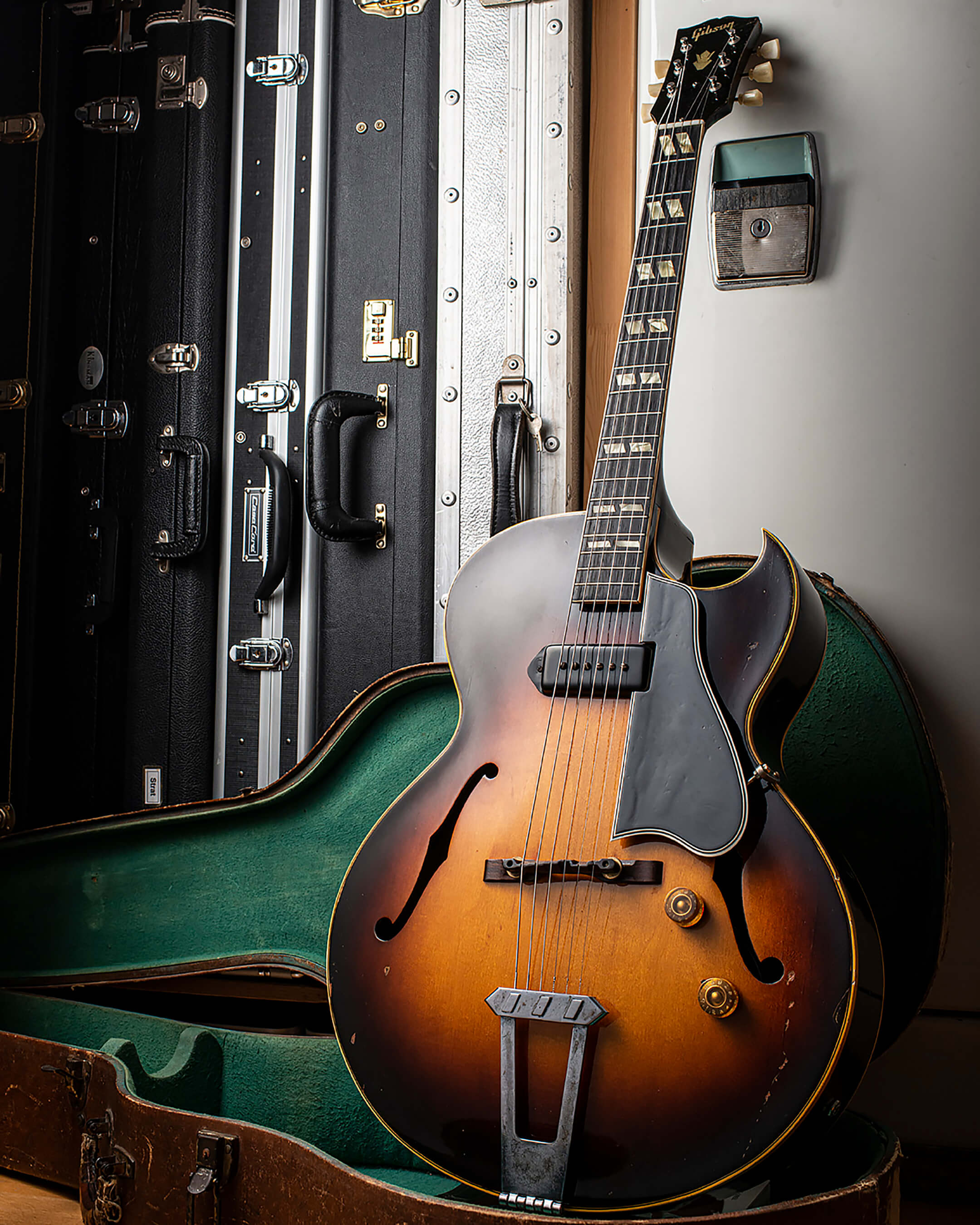
1956 Gretsch Duo Jet
“I was collecting Les Pauls but I do like other singlecuts. I’ve never really got on with Gretsch guitars – it’s been mutual, in fact – but I persisted and I found this one for sale in Germany. They changed the spec on this guitar almost every time they made it. They used different logos, inlays, bridges and tailpieces, pickups. Vintage Gretsch guitars, especially the bigger bodies, often have binding issues but this one has been stable.”
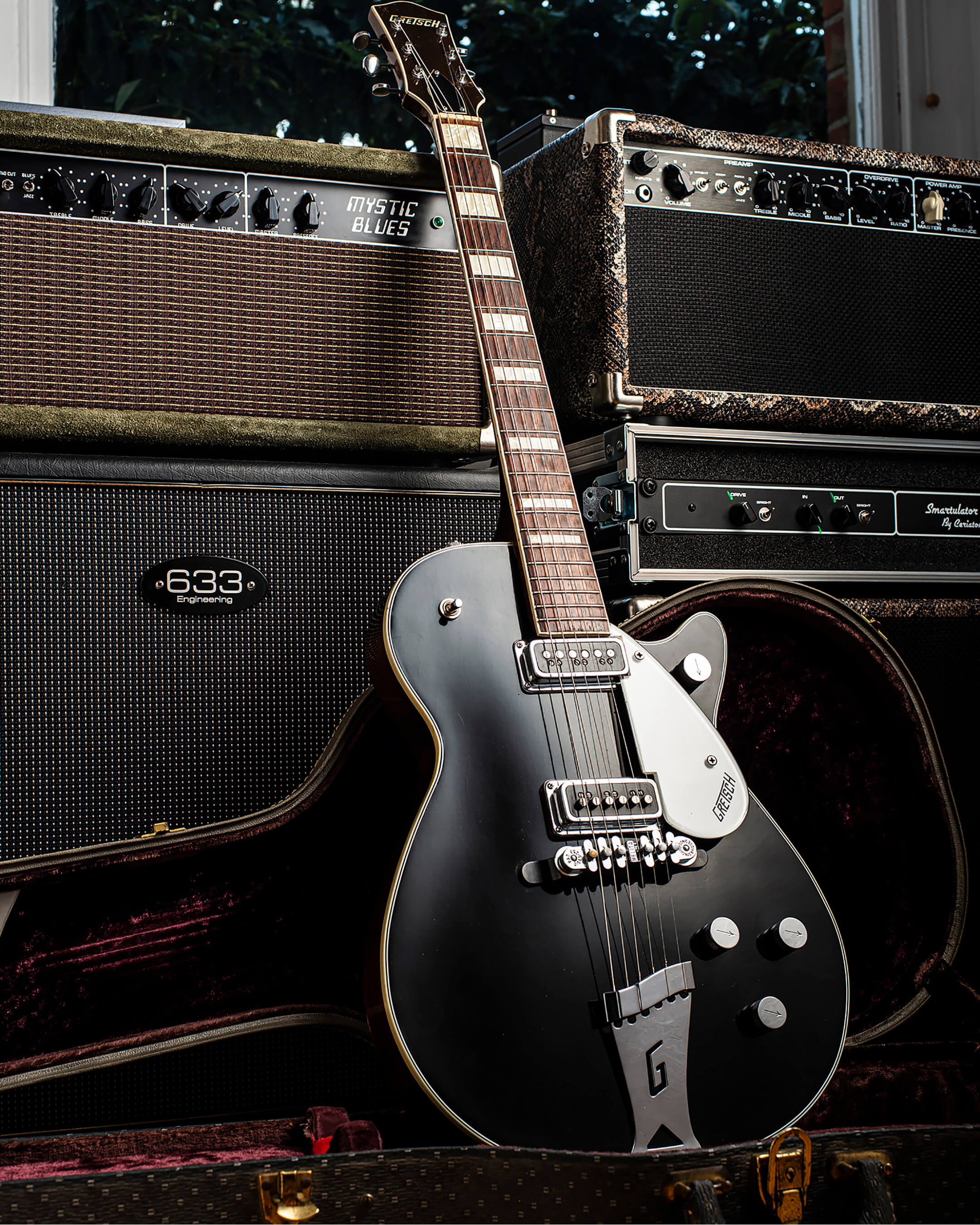
1965 Epiphone Texan
“This came in an unusual but authentic Epiphone cardboard snakeskin case. It’s got a nice sound, medium heft, not too beefy. These are considered great singers’ guitars and the reason they are pricey is Paul McCartney wrote Yesterday on his. I bought this because I worshipped Al Stewart and he played one. The only thing about this guitar is that the distance between the strings and the soundboard is not particularly big so installing a soundhole pickup is difficult – most of them protrude too much.”

1964 Guild M-20
“Look, it’s the same model as the one on the cover of Bryter Layter and I’m a massive Nick Drake fan. It’s really that simple…”
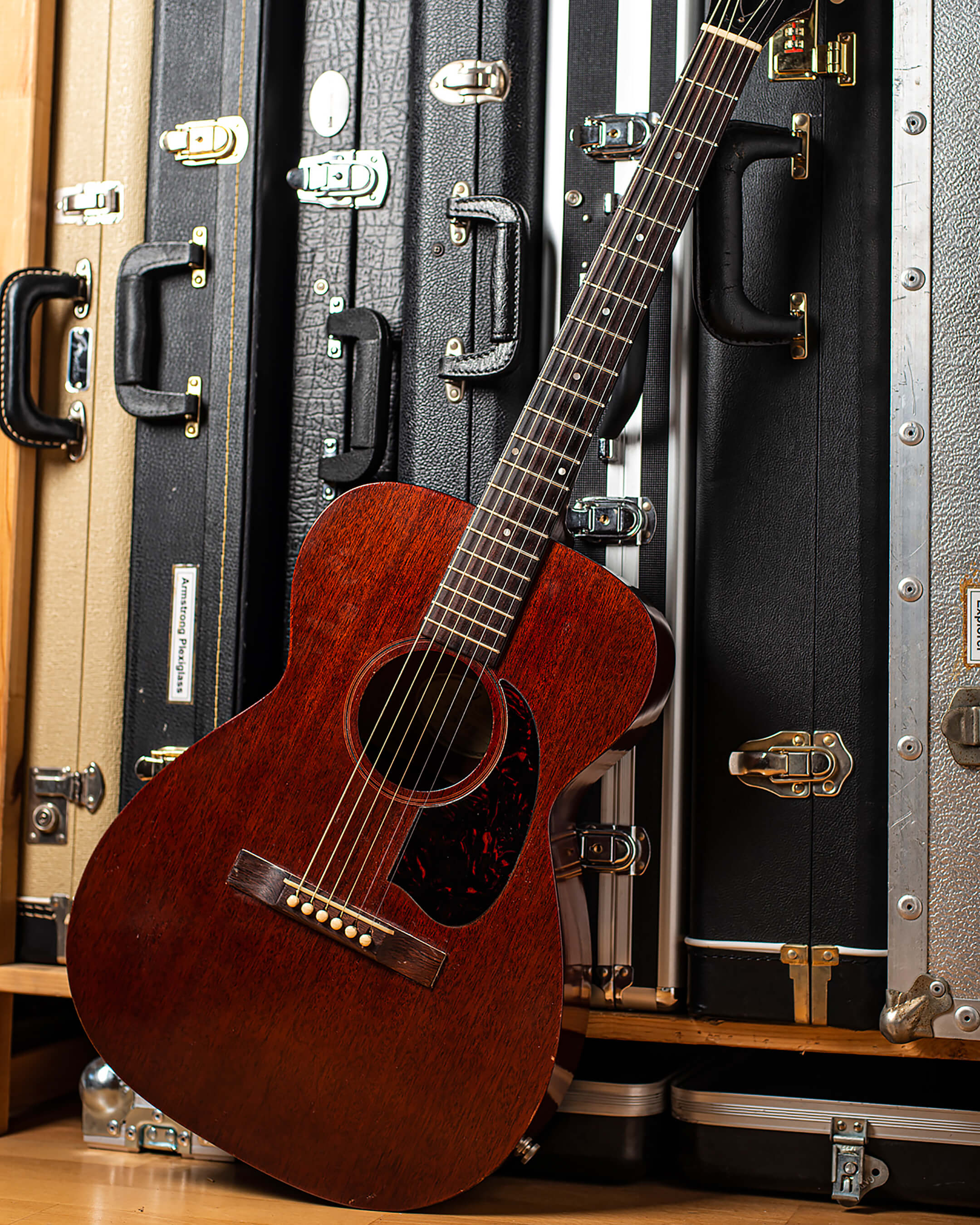
To see and hear more from Bob’s guitar collection, visit rockbeareguitars.com.


